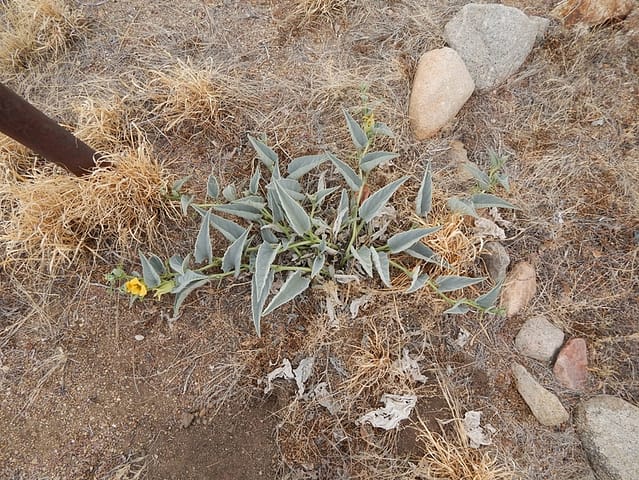Buffalo Gourd Hard to Love

Along the side of highways, often creeping along disturbed soil, tendrils of the buffalo gourd seem like something out of a science fiction film. Extremely fast growing, the large triangular leaves can take over large swaths of land, primarily in elevations below 7,000 feet. The plant is foul smelling and the flesh of the tennis ball-size gourds contain cucurbitacins which can be toxic if consumed in large quantities—difficult to imagine given its stunningly acrid taste.
Despite these offensive attributes, buffalo gourds have a long and useful history in the Southwest. According to Cutler and Whitaker in their “History and Distribution of the Cultivated Cucurbits in the Americas” (American Antiquity 26 (4): 469-485), roots were found in the Tularosa Cave, located in Catron County, and seeds recovered from Hinds Cave on the Pecos River. Radiocarbon dating of the seeds date them from 5,000 years ago.
According to http://outdoorselfreliance.com/buffalo-gourd/, several native cultures used the buffalo gourd for many medicinal and non-medicinal purposes. Its leaves and root were mashed and applied to sores and the torso for chest pains, the root was used as a laxative and the gourds were used as rattles.
Its leaves were also used as soap. Pinching off leaves and rubbing with water creates a lather, although the miniscule spines can cause irritation. The root was boiled and used as shampoo and, according to NMSU’s website http://medplant.nmsu.edu/buffalo.shtm, the flesh of the gourd eliminates grease from wood floors.
The seeds hold promise as a possible food source. Carolyn J. Niethammer in her “The Tumbleweed Gourmet: Cooking with Wild Southwestern Plants,” writes that the seeds contain 37 percent high quality protein. The seeds can be roasted or boiled and then eaten or ground into a meal. Oil can be pressed from the seeds and contains linoleic and oleic acids which are polyunsaturated omega-6 and monounsaturated omega-9 fatty acids. The downside of this oil is that it goes rancid relatively quickly. Still, given its large taproot several academic groups are looking to the perennial as a possible food source, especially for arid areas.
Anyone interested in buffalo gourd oil or using the plant medicinally should consult a trained herbalist.
For the rest of us, perhaps knowing that the sinister-looking plant that grows like crazy and smells so bad has important positive uses can make its aggressive take-over of right-of-ways a little more tolerable and even appreciated.